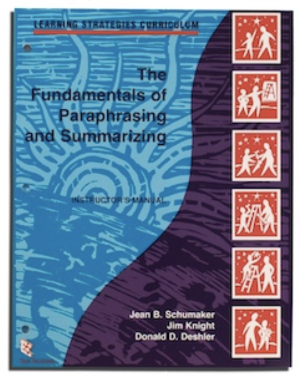The Fundamentals of Paraphrasing and Summarizing Strategy

Fundamentals of Paraphrasing and Summarizing helps older students acquire the fundamental skills they need to be able to identify and paraphrase main ideas and details. Lesson topics include paraphrasing words, phrases, and sentences; identifying details, topics, and main ideas; creating summaries; and more. These skills are foundational to being able to paraphrase and summarize information and are required when students write answers to questions or write reports in school.
Author(s):Jean B. Schumaker, Jim Knight, and Donald D. Deshler
Publication Info: Edge Enterprises, 2007
The Story Behind the Fundamentals of Paraphrasing and Summarizing Program from author Jim Knight
In 1999, as I was directing a comprehensive school reform project called “Pathways to Success,” my colleagues and I shared many of the learning strategies with general education teachers in the Topeka, Kansas School District. We found that teachers loved to teach the writing strategies because every skill that each student had to learn was taught explicitly in sequence with other skills. The writing strategy instruction was very step-by-step, and that was really helpful for students and teachers. In particular, the teachers told us that the Fundamentals of the Sentence Writing Strategy program was very helpful because it provided students with the essential background skills they needed as prerequisites for the more complex writing strategies and helped them become successful writers.
I decided to create a Fundamentals of Paraphrasing and Summarizing program, modeled on the Fundamentals of Sentence Writing Strategy program. I adapted the instructional format to teach some foundational reading strategies and skills. Over a semester, I created the learning sheets and tried them out in collaboration with teachers, modifying the materials based on their feedback. Then, we conducted the first of two studies using the materials with seventh-grade students at French Middle School.
Early in the process, I convinced Jean Schumaker to collaborate with me on the project. She wrote the instructor’s manual and provided suggestions about the format of the materials. Jean also added and created the final lesson. I did a second study, again with seventh-grade students at French Middle School, and both studies demonstrated significant gains for students who received instruction in the strategy compared to students who had not received the instruction.
Author's Thoughts About the Fundamentals of Paraphrasing and Summarizing Program
The Fundamentals of Paraphrasing and Summarizing program is designed to be used in both large-group and small-group instructional situations. I first used the program in reading classes with more than twenty students, and it worked very well, thanks in large part to the learn- by-watching, learn-by-sharing, learn-by-practicing approach, which is modeled after Anita Archer’s “I do it, We do it, You do it” approach.
My other goal, when creating the learning sheets, was to provide teachers with all of the reading passages so they would have everything they need to teach the skills, and I really wanted to create readings that would be interesting for students. I also hoped that the readings would be prompts for lively discussions in the classroom.
Teacher and Student Feedback on this Program
When I did my initial study of the Fundamentals of Paraphrasing and Summarizing program, I heard many encouraging comments. Perhaps most importantly, students who were struggling learners were happy to plot their progress and show me just how well they were doing. Their teacher reported that she saw students who had been struggling all year succeeding with the materials.
Since then, I’ve received dozens of emails from teachers who are grateful for the step-by-step structure of the lessons and for the inclusion of all the reading passages they need to teach the skills. Teachers have also written to say that they really didn’t know how to teach these skills before they learned about this program, but now they feel they clearly understand how to teach students the basic skills associated with paraphrasing and summarizing.
There are multiple products associated with this strategy (instructor and student manuals) available through the publisher, Edge Enterprises, Inc.
Please note that professional development, coaching, and infrastructure support are essential components to effective implementation of SIM instructional tools and interventions. It is highly recommended that you work with a SIM professional developer. An Online Professional Development Course is available for this strategy.
An accessible version of the documents on this site will be made available upon request. Please contact the KU CRL Professional Development Research Institute, at simpd@ku.edu to request the document be made available in an accessible format.